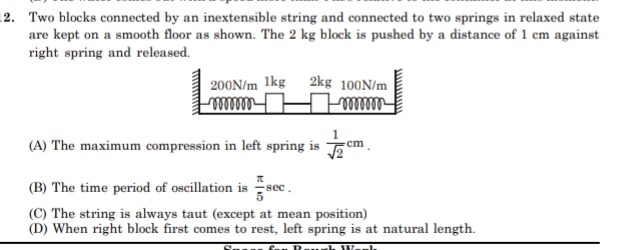Question
Question: Two blocks connected by an inextensible string and connected to two springs in relaxed state are kep...
Two blocks connected by an inextensible string and connected to two springs in relaxed state are kept on a smooth floor as shown. The 2 kg block is pushed by a distance of 1 cm against right spring and released.

The maximum compression in left spring is 21cm.
The time period of oscillation is 5πsec.
The string is always taut (except at mean position)
When right block first comes to rest, left spring is at natural length.
The time period of oscillation is 5πsec.
Solution
The system can be treated as a single effective oscillator with a total mass M=m1+m2=1 kg+2 kg=3 kg and an effective spring constant keff=k1+k2=200 N/m+100 N/m=300 N/m. The time period of oscillation for such a system is given by the formula T=2πkeffM. Substituting the values, we get T=2π300 N/m3 kg=2π1001=2π×101=5π seconds.
Let's analyze the other options: (A) If the string is always taut, the system oscillates as a single mass. The displacement from equilibrium is y(t)=−0.01cos(ωt), where ω=m1+m2k1+k2=10 rad/s. The maximum compression in the left spring occurs when y1 is minimum. If y1=y2=y, then the maximum compression is ∣ymin∣=∣−0.01∣=0.01 m or 1 cm. Option A states 21cm, which is incorrect.
(C) The tension in the string can be calculated. For the 1 kg block, m1y¨1=−k1y1+T. Assuming y1=y2=y, T=m1y¨+k1y=m1(−ω2y)+k1y=(k1−m1ω2)y. With k1=200, m1=1, ω=10, T=(200−1×102)y=100y. Since y(t)=−0.01cos(10t), T(t)=100(−0.01cos(10t))=−cos(10t). The tension is negative when cos(10t)>0, which means the string becomes slack. Thus, the string is not always taut.
(D) The right block first comes to rest when its velocity is zero. y˙2=dtd(−0.01cos(10t))=0.1sin(10t). Setting y˙2=0, the first time is 10t=π, so t=π/10. At this time, y2(π/10)=−0.01cos(π)=0.01 m. If the string were taut, y1=y2=0.01 m. The left spring is at its natural length when y1=0. Since y1=0.01 m, the left spring is stretched, not at its natural length.
